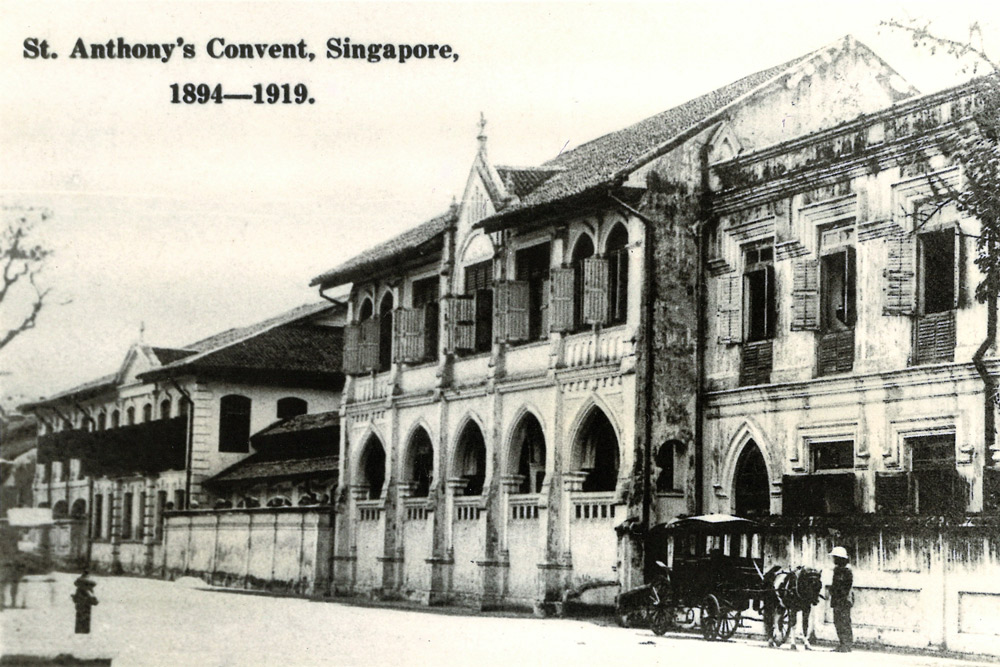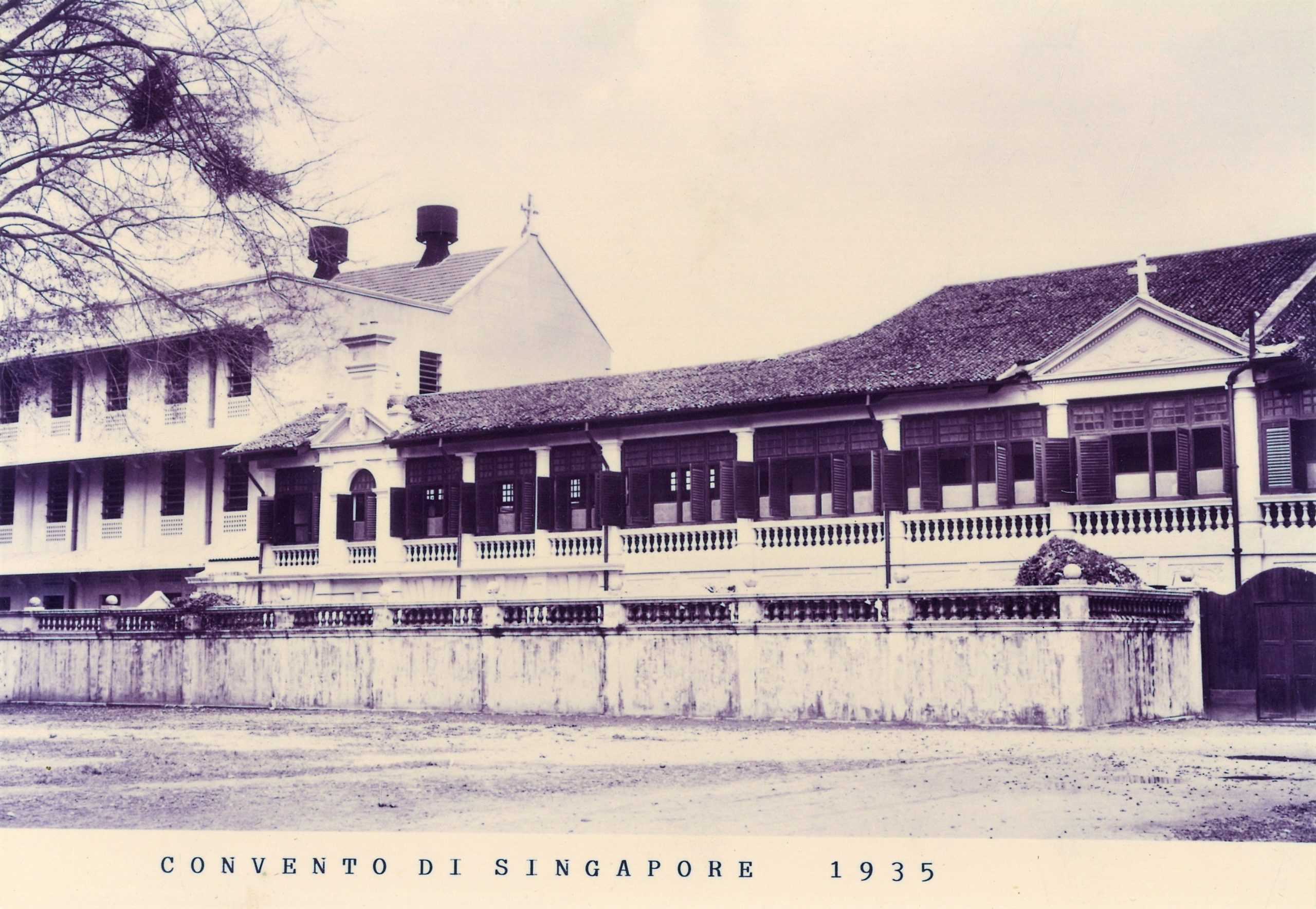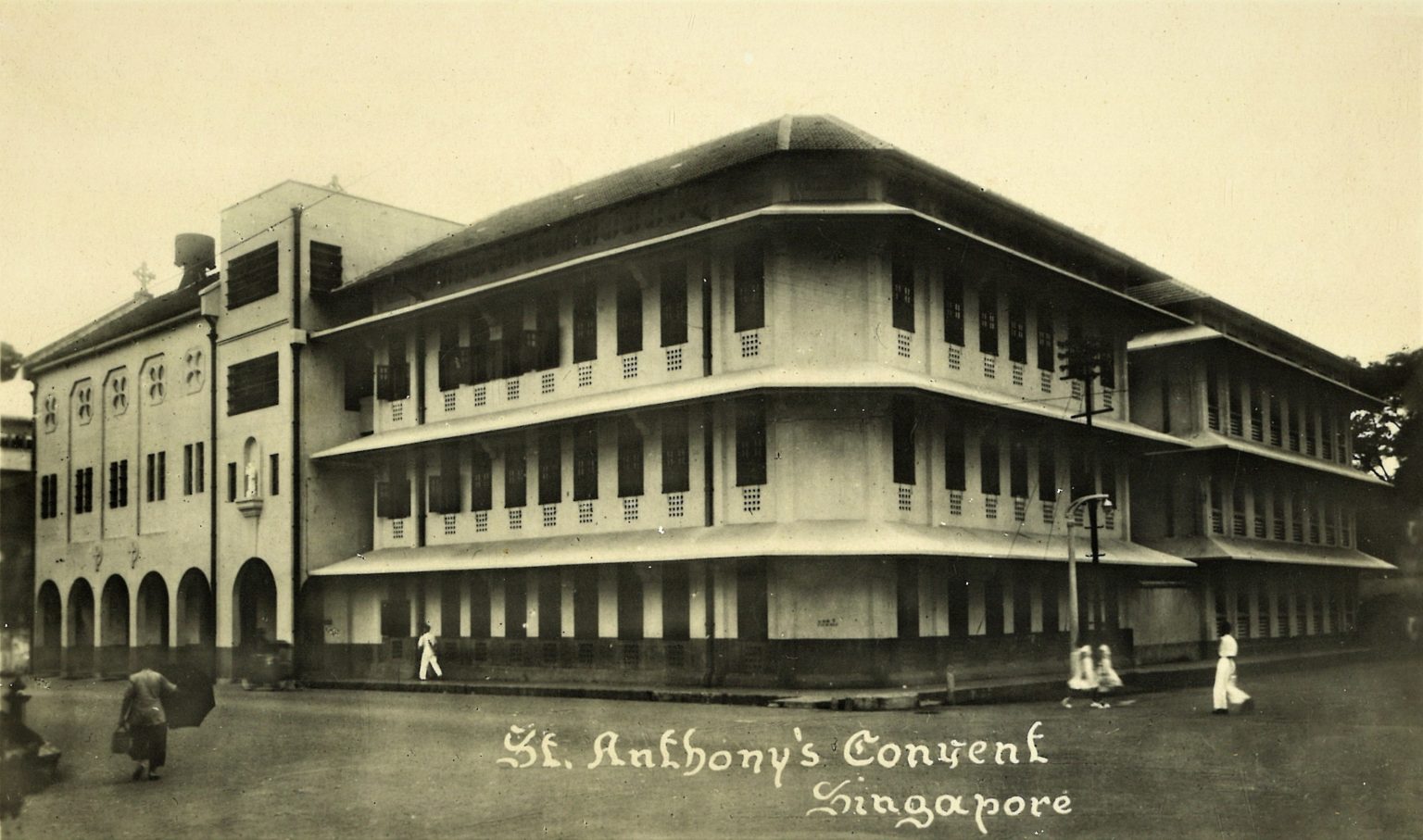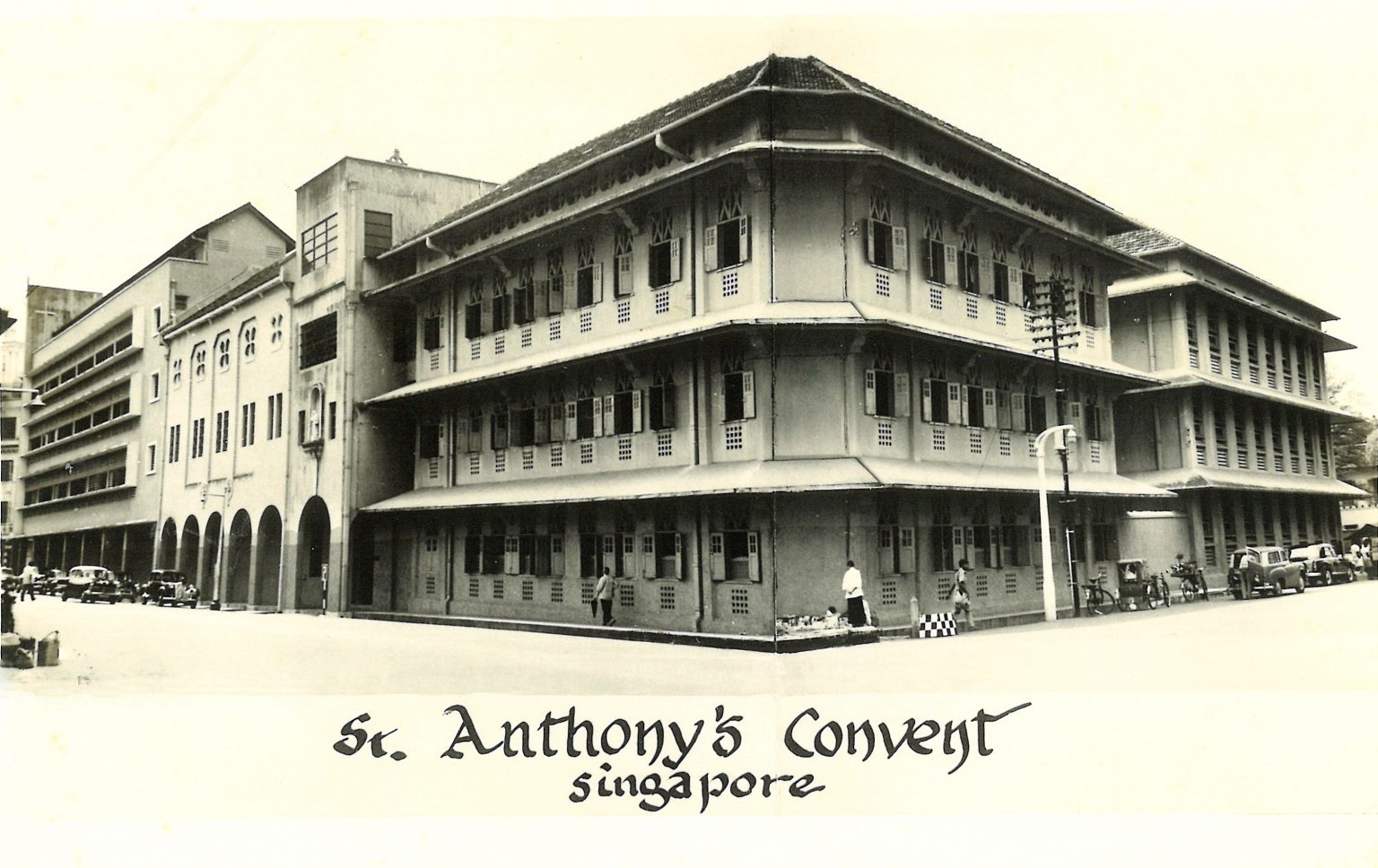School History
1879 – 1894: Beginnings in Singapore
On 1 August 1879, Fr. Jose Pedro Sta Anna de Cunha of the Portuguese Mission in Singapore started St. Anna’s School in a two-storey rented shop-house in Middle Road for the education of poor parishioners. It had six students and a staff of three expatriate school teachers.
When Fr. Nicholas Pinto took over in 1881, he put up a new building for the school. The school was renamed St. Anthony’s Boys’ and Girls’ School and inaugurated on 23 February 1886.
In November 1893, at the suggestion of the Inspector of Schools, the girls were separated from the boys. Two schools were set up: St. Anthony’s Girls’ School with 73 girls and St. Anthony’s Boys’ School with 143 boys.
1894: The Canossian Presence

As there was a need to provide religious education for the girls, Fr. J.J Baptista, a co-adjucator of the Church sought help from Bishop Medeiros in Macau. The Canossian Sisters from Hong Kong and Macau were then invited to come to Singapore to take over the school for the girls.
On 11 December 1894, four Canossian Daughters of Charity - Mother Teresa Rossi, Mother Justina Sequeira, Mother Mathilde Rodriguez and Mother Marietta Porroni - arrived from Macau. They were accompanied by Rev. Mother Maria Stella and Rev. Mother Teresa Lucian, Superiors of Hong Kong and Macau respectively. In addition to running the school, the pioneer missionaries also set up an orphanage cum boarding house with five orphans and eight boarders respectively.
The School situated at 111 Middle Road was renamed St. Anthony’s Convent School in 1894. The Sisters emphasized education in the faith and values besides offering a quality education. To ensure that over-aged children were not excluded, vocational schooling was provided for these young women to equip them for work. The Sisters also provided refuge for the poor. Under their charge, the enrolment of students, boarders and orphans increased significantly.
In 1896, the School welcomed its first appointed Sister Principal, Sr. Anna Bennet, from Hong Kong. By 1899, the school enrolment had doubled and a new wing was added, through contributions from the Portuguese Mission, subsidies from the private sector and the Government. The Sisters continued to provide education mainly to the disadvantaged.
1929: A New School Building

In August 1928, the old school was demolished and a $49,000 new building with twelve classrooms stood in its place the following year. During this construction period, the girls occupied St. Anthony’s Boys’ School. A new Chapel and new quarters for the nuns adjoining the school were completed in 1933.
1935: Senior Cambridge Class
In 1934, the first Junior Cambridge class started, followed by the Senior Cambridge class in 1935. This fulfilled the goal of the Sisters in providing the girls a complete course of education that opened up opportunities for employment and higher education.
1940s: Surviving the War


During World War II, classes were disrupted and the school became a refuge for the Red Cross and those who lost their homes and their loved ones. Classes resumed but lessons were taught in Japanese.
In 1943, the Italian Sisters were placed under house arrest. Their freedom was secured a month later, after they had signed an oath of allegiance to the Japanese government. This was the only way for the Sisters to continue with their work.
When Italy left the Japan-Germany war alliance, the four Italian Sisters were dismissed. This threatened the closure of the schools. However, the Sisters rose to the occasion. By appointing a lay person as the principal and replacing the four Italian Sisters with four young local novices, they ensured the continuity of the school.
When the war ended, the Sisters resumed their mission with renewed zest. Enrolment in the school grew exponentially such that more facilities were needed. The older part of the school was demolished and in its place a 5-storey building equipped with Science laboratories and Home Economics rooms to cater to the new curriculum.
1970: Separation of Primary and Secondary Schools
In 1970, the administration of the Primary and Secondary Girls’ Schools were separated. The following year, Pre-university classes were added offering the A-levels. By 1972, the noise levels of the adjacent Victoria Street and Middle Road made it unconducive for teaching and learning. Air conditioners were added to all the classrooms of the secondary school.
The 1980s: Going Above and Beyond
When the “Normal” Stream classes were introduced to secondary schools, the Sisters reflected on their calling to serve the disadvantaged and put up a request to offer Normal Stream. Provisions were also made for hearing-impaired students to join mainstream classes from 1989 to date.
1993: Performing Arts (PfA) Programme
The Performing Arts Programme (PfA) was launched in 1993. Although the main objective was to provide opportunities to develop the talents of the students and cultivate appreciation of the Arts, the PfA programme also provided a platform for students across all races, religions and streams to mingle.
1994: Centenary Celebrations and Official Closing of Middle Road
To celebrate 100 years of Canossian Sisters educating women in Singapore, the school put up a musical drama entitled “Wings or Canossa” in March 1994 at the Victoria Theatre. The commemoration included an Alumni Centenary Dinner held on 20 August that was attended by distinguished guests including the Archbishop of Singapore, Gregory Yong, the Ambassador of Italy as well as past and present teachers and administrators of St. Anthony’s Convent. The centennial celebrations ended on a high note with the Centenary Mass held on 11 December 1994, where Pope John Paul II sent his apostolic blessing to the Canossian Sisters and teaching staff at St. Anthony’s Convent.
The Flag Lowering & Gate Closing Ceremony held on 9 November 1994 at St. Joseph’s Church compound, signified the end of school life at 111 Middle Road. The gate which had stood for 100 years was a gateway to knowledge, education and cherished friendships with Sisters, teachers and friends, providing security to all who entered was closed for the very last time and Sr. Angela Ng, the Principal of the Primary School, removed the ‘St. Anthony’s Convent’ plaque.
1995 - 2001: New Campus, New Beginnings
To provide for better amenities, facilities and education in an ever-changing environment, the the Primary and Secondary Schools of St. Anthony’s Convent moved to its current location at Bedok North Avenue 4 in 1995 under the leadership of Sr. Angela Ng and Sr. Cecily Pavri. The new campus sprawled over 2.3 hectares and costing $28 million. The Sisters were housed in a separate building behind the primary school. Both schools were renamed as St. Anthony’s Canossian Primary School (SACPS) and St. Anthony’s Canossian Secondary School (SACSS) to honour the legacy of the Canossian spirit. The schools were officially opened in July 1996.
2002 to 2007: Autonomous Status and Performing Arts Education
SACSS was conferred the Autonomous school status in recognition of the strong academic and co-curricular outcomes in 2002. The school uniform was also redesigned to commemorate its Autonomous status. The year ended with a watershed historical event. After 108 years of Sister-Principals, Sr. Cecily Pavri, was the last Canossian Sister-Principal to lead the School. She handed over the reins of leadership to Mrs Jennifer Loh, the incumbent Vice-Principal, on 1 January 2003. SACSS was officially acknowledged as a niche for Performing Arts Education (PfE) in 2004. In 2005, SACSS took another leap in its PfE programme when Drama was offered to students as an O-level School Initiated Examination (OSIE). The school received another prestigious award, the Best Practice Award for Teaching & Learning, in 2007.
2007 to 2020: Growing from Strength to Strength
When Ms Melanie Martens took over from Mrs Loh, she deepened the school’s curriculum reform efforts further to implement Brain-Based Learning that guided teachers’ engagement strategies based on principles derived from solid scientific research to create positive learning environments. Brain-Based Learning strategies, such as the EAGER protocol, continue to be practiced in SACSS. Between 2009 and 2013 through the Programme for Rebuilding and Improving Existing schools (PRIME) project, the school facilities were upgraded.
In 2014, the baton of school leadership in the secondary school was handed over to Mdm Mak Lai Ying. Under her leadership, SACSS sustained value-added results and was a forerunner in piloting Subject-Based Banding and the use of Student Learning Space (SLS) in teaching and learning. To create conducive learning environments, Mdm Mak made continual improvements to our physical facilities, especially in the school library, and revived the reading culture. Together with the principals from the Canossian schools, they collaborated on many projects which led to stronger bonds being established amongst them, the effects of which continue to be manifested even today.
With the passing of the leadership baton from Sister Principals to lay school leaders and teachers, the Canossian Charter was written and launched in 2017 by the Canossian Charism Formation Team to capture the core values and principles of Canossian Education. It aspires to extend the spirit and legacy of St. Magdalene of Canossa into the decision-making and every day of school life for the Canossian schools.
2020 and Beyond
In 2020, the secondary school embarked on a re-envisioning exercise to redefine the vision, mission and values of the school in order to unite the various Canossian schools towards the common purpose. Other than the sisters and our affiliated primary schools, input was also sought from our students and teachers.
What started as a cause to educate a few poor children at St. Anthony’s Convent has evolved into a quality school that offers a comprehensive curriculum, ensuring that every child is given the best of opportunities to develop her talents and grow in character shaped by the Gospel values of Jesus Christ. The St. Anthony’s Canossian Schools believe that our Canossian brand of education will continue to prepare our students to better meet the challenges for the future.

